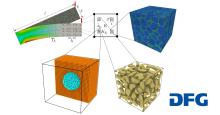Nano-micro scale transition through atomistic continuum coupling via homogenization

Funding: DFG, 01.01.2020 - 31.12.2025
Collaboration: Prof. Karsten Albe, TU Darmstadt
Project ID: Deutsche Forschungsgemeinschaft (DFG) - Projektnummer 440847672
Atomistic computer simulations based on classical interatomic potentials allow the description of material properties and processes with high temporal and spatial resolution but are limited to small system sizes (typically < 1 billion atoms). As a result, macroscopic length scales are inaccessible to these methods. The goal of this research project is therefore to develop a two-scale atomistic-continuum coupling method that realizes a nano-to-micro transition for nano heterogeneous solids through homogenization, enabling the simulation of material and structural behaviour using interatomic potentials on previously unattainable length scales.
The proposed atomistic-continuum coupling method will be implemented through an effective combination of proven, parallelized simulation components. To achieve this objective, the research project builds on existing theoretical and methodological concepts of the FE2 method and the FE-HMM, which themselves are based on Hill-Mandel's postulate of the equality of strain energy density on both length scales. Unlike the micro-to-macro transitions within the framework of the FE2 method and the FE-HMM, no constitutive law of continuum mechanics has been established for the nano-to-micro scale transition at the level of representative volume elements. Therefore, analytical interatomic potentials will be utilized in this approach.
At the nanoscale, a molecular statics solver will be employed, interfaced with a micro-FEM solver. The coupling variables at the micro-to-nano interface include the microscopic deformation gradient, while those from nano to micro comprise the first Piola-Kirchhoff stress tensor averaged over the representative volume element at the nanoscale, as well as the effective tangent moduli. The accuracy, stability, convergence properties, and performance of this hybrid method will be analyzed for selected material systems spanning from elastic to large elasto-plastic deformations. These material systems include, in particular, nanocrystalline polycrystals, single crystals with spatially distributed dislocations, and nanoporous structures.
Through this two-scale coupling method via homogenization, the simulation of material and structural behaviour of nano heterogeneous solids, with the precision of interatomic potentials, will be directly extended to length scales of micrometers—and beyond—which was previously considered unattainable.